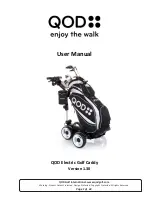
QOD Golf International. www.qodgolf.com
Warning: Product Patent Protected, Design Protected, Copyright Protected. All rights Reserved
Page 12 of 24
Charger and Battery
•
Do not expose the charger to rain, moisture or dampness; if you suspect any of
these have occurred, then do not use the charger.
•
Do not connect the charger to an overloaded charging outlet with many other
devices. The charger needs constant power to fully charge a battery.
•
Do not wrap or cover the charger, as chargers generate heat in use.
•
Do not use the charger or battery if the leads, contacts or casings are damaged.
•
Do not leave the charger connected to the battery with main supply switched
off.
•
Do not leave the battery in a discharged condition; this will dramatically reduce
The life of the battery, and your charger may be unable to recharge it. This
could also permanently damage your battery.
•
Do not discharge your battery other than in normal use. The charger will not
charge an over-discharged battery.
•
Do not submerge the lithium battery in water, or deliberately spray with water
or other liquids. To clean, use a lightly dampened cloth.
•
IMPORTANT: If submerged under water or if water may have entered due to
damage to casing, place outdoors in a non-combustible container covered in
sand away from other flammable material, and contact QOD or your local
authority for further advice.
•
Do not leave the battery on charge in temperatures below 0 °C (32 °F) or expose
the lithium battery to temperatures below -5 °C (23 °F) or above 40 °C (104 °F).
•
Only use a Mini Miser charger with your battery. A mismatch of battery and
charger could cause damage.
•
Chargers have two lights (can be combined in one bulb). When connecting a
discharged battery, red/amber will illuminate. The light will turn green during
the charging cycle. Please ensure that the charger always starts on red when
charging a discharged battery.

























